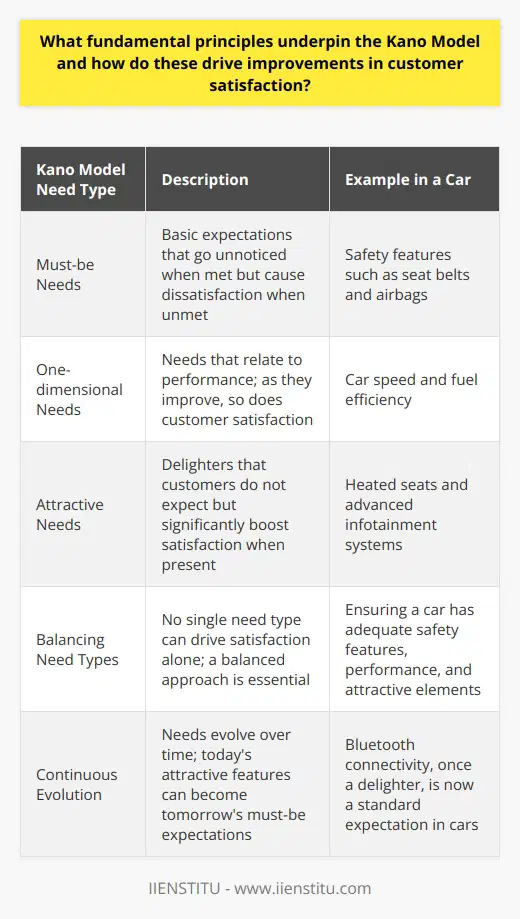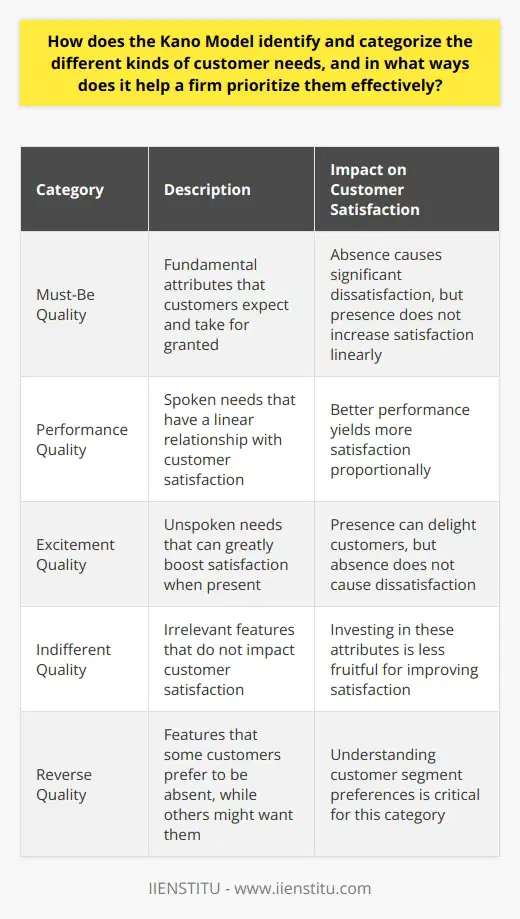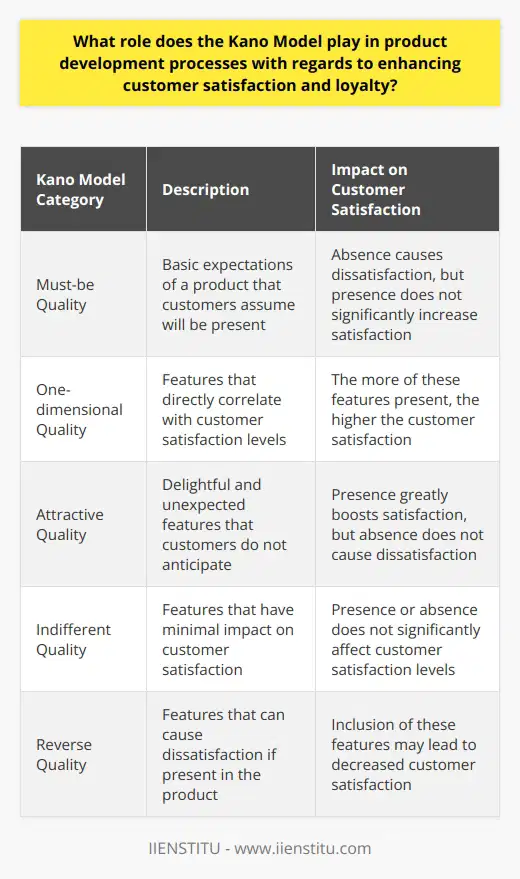
In the ever-evolving quest for enhanced customer contentment, businesses across various segments continue to search for robust analytical frameworks capable of deciphering the complexities of consumer preferences. Amidst the plethora of theoretical constructs that exist today, the Kano Model has emerged as a beacon, guiding product development and service management towards more nuanced, user-centered paradigms. This insightful article embarks on a journey through the Kano Model, unraveling its comprehensive approach to reinforcing customer satisfaction, and exploring its significant utility in modern enterprises.
Introduction to Kano Model
Brief history of the Kano Model and its purpose
The Kano Model was developed in the 1980s by Professor Noriaki Kano. It was birthed from the discernment that customer preferences are multifaceted and that their satisfaction with product features does not invariably align on a simple linear scale.
Professor Kano's work delineated the notion that some attributes of a product or service could deliver disproportionate levels of satisfaction, or dissatisfaction, depending on how well they are executed. The model's purpose is two-fold: firstly, to aid in identifying different categories of product features; and secondly, to guide the prioritization process in development such that it resonates with user satisfaction.
Explanation of how the Kano Model works
The Kano Model functions by categorizing product features into several types based on how they impact customer satisfaction. These categories include the must-be attributes, which are the basics that if not met, result in customer dissatisfaction; performance attributes, which are directly correlated to the level of satisfaction; and attractive attributes, which are not expected but can cause delight if present. The essence of the Kano Model lies in the utilization of these categorizations to structure product development strategies that satisfy and often exceed customer expectations.
The importance of using the Kano Model in product development
Employing the Kano Model in product development is integral to ensuring that customer-centricity remains at the core of the process. It provides a structured approach to interpreting varied consumer feedback, something that is especially crucial in today's market where customer preferences are rapidly changing. By understanding the intricate balance between minimum expectations and potential delighters, companies can more effectively allocate resources and innovate in areas that yield the greatest impact on customer satisfaction.
Understanding the Basics of Kano Model
Ishikawa Diagram (Fishbone Diagram): A Comprehensive Guide to Effective Analysis
5S Methodology: A Comprehensive Guide for Process Optimization in Businesses
Nominal Group Technique (NGT): An Efficient Tool for Decision Making
Detailed explanation of the Kano Model categories
Performance attributes
Performance attributes are those that customers directly associate with the value of a product or service; these are the features they are willingly paying for. As performance improves, so does customer satisfaction at a somewhat proportional rate. For example, an increase in the battery life of a smartphone typically increases customer satisfaction. However, failure to perform at an expected level can just as easily lead to customer dissatisfaction.
Must-be attributes
Must-be attributes, also known as basic or expected attributes, constitute the fundamental requirements that customers naturally assume will be present in a product or service. These include basic functionalities or standards which, when unmet, cause dissatisfaction but do not necessarily increase satisfaction when fulfilled; they are merely expected.
An example might be the safety features in a car, which when absent can lead to extreme dissatisfaction but when present are often overlooked because they are assumed as standard.
Attractive attributes
Attractive attributes, or delighters, have the unique capacity to significantly boost customer satisfaction if provided, but their absence does not cause any particular dissatisfaction as they were never expected initially. These attributes are often sources of innovation and can sharply differentiate a product in the marketplace, such as fingerprint sensors in phones when they were first introduced.
These delighters carry the potential to transform users into loyal customers and vocal advocates of the brand.
The complexity and dynamism of customer needs
Gauging customer needs is a complex task, largely due to their dynamic nature. Factors such as cultural shifts, technological advancements, and personal experiences continuously reshape what customers perceive as basic, performance, or delightful. Over time, delighters can become performance attributes, and eventually must-be attributes as the market standard rises. Understanding this fluidity is crucial for businesses in maintaining customer satisfaction.
The Process of Implementing the Kano Model
The significance of customer surveys in the Kano Model
The implementation of the Kano Model commences with well-structured customer surveys. These surveys are designed to gauge the feelings and reactions of customers about specific product features. The method generally employs a dual questioning tactic for each feature: how do customers feel if they have the attribute (positive question) and how do they feel if they do not have that attribute (negative question)? The intersection of these two perspectives provides rich insight into which category each feature falls into within the Kano framework.
Explanation of how to interpret the customer responses
Subsequent to the collection of survey data, the responses are interpreted using a matrix that correlates positive and negative reactions. This interpretation aids in categorizing features into the Kano Model's various types. The meticulous analysis of this feedback is pivotal as it influences the strategic decisions around product development, thereby directly affecting the potential to meet and exceed customer expectations.
An in-depth look at the data analysis process in Kano Model
Data analysis in the Kano Model is an intricate process, necessitating careful consideration of nuanced customer responses. It frequently involves qualitative examination to fully comprehend customer emotions and preferences, as well as quantitative methods to identify trends and patterns. This data not only informs current product development but also serves as an invaluable repository of consumer insights for future innovations.
Advantages and Limitations of the Kano Model
Discussion on the benefits of using the Kano Model
The Kano Model provides an excellent framework for businesses to comprehend the multifaceted nature of customer satisfaction. It enriches the decision-making process by highlighting the significance of various product features, emphasizing innovation in delighters, and establishing clear guidance for prioritization. Furthermore, it nurtures a culture of customer focus, pushing companies to consistently meet and exceed customer expectations, fostering brand loyalty, and creating a competitive edge in crowded markets.
Outline of potential drawbacks and limitations of the model
Despite its numerous benefits, the Kano Model is not without its constraints. One limitation is the static nature of its classification, which may fail to account for the evolution of customer perceptions over time. Another concern is that it requires a substantial amount of quality data to yield accurate results, which can be resource-intensive. Additionally, differentiating between delighters and performance attributes can sometimes be ambiguous, making strategic decisions challenging.
Ways to overcome the limitations of the Kano Model
To mitigate the limitations of the Kano Model, businesses should continually update their understanding of customer needs through recurrent market research and survey deployment. Adaptability and responsiveness to market changes can help transcend the static nature of the model. Also, leveraging data analytics can enhance the precision of the model and inform more nuanced decision-making processes.
Kano Model in Different Business Sectors
Application of Kano Model in the manufacturing industry
In the manufacturing sector, the Kano Model is instrumental in guiding product innovation and quality control. By recognizing that certain features can dramatically amplify customer satisfaction if executed well, manufacturers can prioritize these in their product roadmaps. This targeted focus on customer desires supports manufacturers in producing items that not only adhere to market demands but also fuel customer advocacy and market differentiation.
Usage of Kano Model in the service industry
In service-oriented fields, the Kano Model's role is equally pivotal. From hospitality to financial services, understanding what drives client satisfaction and loyalty is a cornerstone of success. The Kano Model assists in delineating between table stakes in the industry and potential opportunities for differentiation, allowing service providers to refine their offerings to align with the changing tastes and preferences of their clientele.
Case studies of companies using Kano Model to improve customer satisfaction
Numerous enterprises have showcased the benefits of employing the Kano Model. For instance, an automaker may identify safety features as must-be attributes, fuel efficiency as a performance attribute, and autonomous driving as an attractive attribute. As a result, the enterprise can focus its innovation efforts where they will make the most significant impact. Case studies from such applications illustrate the practical effects of the Kano Model and affirm its robustness in improving customer satisfaction across diverse business sectors.
Conclusion: The Role of Kano Model in Modern Businesses
Summary of the key points highlighted in the blog
Throughout this article, the layered complexity of the Kano Model has been explored, from its innovative classification system and the dynamic nature of consumer needs to the strategized implementation and the insightful advantages it grants businesses. The model's application across varied industries has denoted its versatility as a tool for excellence in customer satisfaction.
The impact of the Kano Model on customer relationship management
By integrating the Kano Model into customer relationship management practices, businesses can elevate the quality of their interactions and deepen customer engagement. The targeted approach the Kano Model promotes ensures that resources are invested in areas that maximize customer delight and cultivate enduring relationships built on satisfaction and trust.
Encouragement for businesses to integrate Kano Model in their strategies
With a firm grasp of the Kano Model, businesses are encouraged to adopt its principles, seeking to enhance their offerings and outdistance market competitors. Incorporating a Kano perspective into strategic plans fortifies a company's resolve to prioritize customer satisfaction as a pivotal success metric.
Final insights on the Kano Model's relevance in the modern business world.
In the rapidly changing landscape of consumer expectations, the relevance and applicability of the Kano Model remain beyond question. As a testament to its continued significance, online certificate programs and problem solving certificate courses often include modules dedicated to mastery of the Kano Model, underscoring its essentiality for professionals who aspire to excel in product design, service management, and customer satisfaction enhancements. Thus, for businesses aiming to thrive in today's customer-driven marketplace, the Kano Model represents an indelible blueprint for success.
Frequently Asked Questions
What fundamental principles underpin the Kano Model and how do these drive improvements in customer satisfaction?
Fundamental Principles of the Kano Model
The Kano Model originates from the work of Dr. Noriaki Kano. It categorizes customer preferences into distinct groupings. These classifications aid businesses in understanding customer needs. They also guide product development and prioritize features.
Understanding Customer Needs
The model considers three types of needs:
- Must-be Needs
- One-dimensional Needs
- Attractive Needs
Must-be needs are basic expectations. They go unnoticed when met but cause dissatisfaction when unmet. For instance, safety in a car is a must-be need. No safety, no satisfaction.
One-dimensional needs relate to performance. As they improve, so does customer satisfaction. Take car speed as an example. Faster cars often mean happier customers.
Attractive needs are delighters. Customers do not expect these. Yet, they significantly boost satisfaction when present. An example is the heated seats in a car. They are not necessary, but they make the driving experience more luxurious.
Driving Improvements in Customer Satisfaction
The Kano Model pushes for a nuanced view of customer satisfaction. It warns against focusing on just one need type.
Balance is Key
A core principle is balance. No single need type can drive satisfaction alone. Overlooking must-be needs undermines basic expectations. Overemphasis on one-dimensional needs escalates costs and complexity. Ignoring attractive needs may result in missed opportunities for delight.
Continuous Evolution
Needs evolve over time. Today's attractive features can become tomorrow's must-be expectations. Continuous feedback is vital. It captures evolving customer desires.
Differentiation through Delighters
Attractives offer competitive advantage. They help differentiate products. Innovative features surprise customers. They create strong, positive associations with the product.
Practical Implications for Businesses
Aligning Product Features with Customer Needs
Businesses can use the Kano Model to align features with needs. This ensures efficient resource allocation. High-priority features receive the necessary attention.
Data-Driven Decisions
Decision-making becomes data-driven. Customer feedback guides feature selection. This makes it more likely that improvements will satisfy customers.
Cost-Effectiveness
Prioritization through the Kano Model ensures cost-effectiveness. It prevents overspending on features that do not enhance satisfaction.
The Kano Model's principles foster a deep understanding of customer satisfaction. They encourage businesses to balance features. They stress the need for continual innovation. They facilitate differentiation in crowded markets. These principles, when applied thoughtfully, drive sustained customer satisfaction and business success.

How does the Kano Model identify and categorize the different kinds of customer needs, and in what ways does it help a firm prioritize them effectively?
Understanding the Kano Model
The Kano Model serves as a tool. It elucidates customer preferences. Noriaki Kano developed it. The 1980s saw its inception. It remains relevant today. The model categorizes needs. It helps prioritize them. Understanding this model is crucial. Firms can target improvements effectively.
Categories of Customer Needs
The model divides needs into five categories. Each serves a distinct purpose. Let's explore these categories.
Must-Be Quality attributes are fundamental. Customers expect these. They deliver basic satisfaction. Absence causes significant dissatisfaction. However, their presence does not increase satisfaction linearly. They are simply essential.
Performance Quality needs are linear. These are spoken needs. Better performance yields more satisfaction. It's a proportional relationship. Customers often compare these attributes.
Excitement Quality is about delight. These are unspoken needs. Customers don't expressly demand them. Yet, their presence can greatly boost satisfaction. In their absence, there's no dissatisfaction. They provide competitive advantage.
Indifferent Quality refers to irrelevant features. These do not impact satisfaction. They are often overlooked. Investing in these is less fruitful.
Reverse Quality is unique. Some customers prefer their absence. Others might want them. It's a matter of personal preference. Understanding your customer segment is critical here.
Prioritization with the Kano Model
The Kano Model aids in prioritization. It informs resource allocation. It helps avoid over-engineering. Firms can focus on what truly matters.
- Identify Must-Haves: Secure the basics first. These are the deal-breakers. Without these, the product fails.
- Balance Performance Features: Optimize these next. They are key differentiators. They increase satisfaction directly.
- Incorporate Delighters: Finally, add excitement features. They surprise customers. They create advocates. They enhance brand loyalty.
Using the Kano Model Effectively
Firms must use this tool judiciously. Regularly reassess customer needs. Needs evolve over time. What was exciting becomes basic later. Constant feedback is necessary. It ensures product relevance. Market research combines with the Kano Model here.
Implementation involves a systematic approach. Start with comprehensive surveys. Analyze customer reactions. Classify feedback using the model. Plan development accordingly. Use resources where they count the most.
The Kano Model is insightful. It deciphers complex preferences. It aids in delivering satisfaction. Ultimately, it guides firms toward innovation. Customer satisfaction is dynamic. It demands focused attention. The Kano Model provides structure. It is a catalyst for customer-centric development.
Firms seeking competitive advantage benefit from this approach. It steers them away from generic features. It guides them toward meaningful enhancement. The result? Products that resonate. Services that delight. Customer needs met with precision.

What role does the Kano Model play in product development processes with regards to enhancing customer satisfaction and loyalty?
The Kano Model: A Framework for Understanding Customer Preferences
In product development, understanding customer needs stands paramount. The Kano Model offers unique insights into these needs. It categorizes features based on customer reactions when fulfilled or unfulfilled. These categories help teams predict the impact on customer satisfaction.
Unveiling Customer Desires with the Kano Model
Norikio Kano, a Japanese professor, developed this model. It shows how different features contribute to satisfaction. Teams use it to weigh the importance of each feature.
The Kano Model breaks down features into five main types:
- Must-be Quality: Basic expectations of a product. Absence causes dissatisfaction.
- One-dimensional Quality: Features that correlate with satisfaction levels. More is better.
- Attractive Quality: Delightful features customers don't expect. They boost satisfaction greatly.
- Indifferent Quality: Features with minimal impact on satisfaction.
- Reverse Quality: Features that can cause dissatisfaction if present.
Elevating Customer Satisfaction and Loyalty
The model aids in prioritizing features. Teams discern which elements bring delight and which are merely adequate. The focus shifts to critical customer-experience aspects.
Guiding Product Development with Purpose
Feature prioritization becomes clear. Teams avoid over-engineering. They invest in features that matter to customers. This focus aligns product development with customer values.
Understanding what customers value fosters better design. Teams deliver products that resonate with the market. They adapt More quickly to changing customer preferences.
Building Loyalty Through Strategic Innovation
The Kano Model encourages innovation. It pushes for features that surprise and delight. Customers become loyal fans. They spread the word about the product. This word-of-mouth marketing is invaluable.
Strengthening Market Position
Products developed with the Kano Model in mind stand out. They match customer needs better. The market sees them as superior options. Competition becomes less of a threat.
Conclusion: The Kano Model's Impact
The Kano Model shapes products that customers love and remain loyal to. It streamlines the development process. It offers guidance on where to invest for the biggest return in customer satisfaction. Use the model; your customers and your bottom line will thank you.



